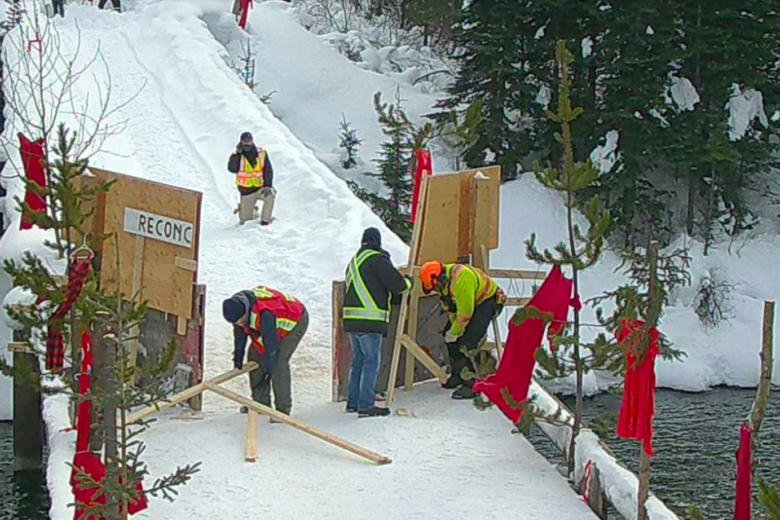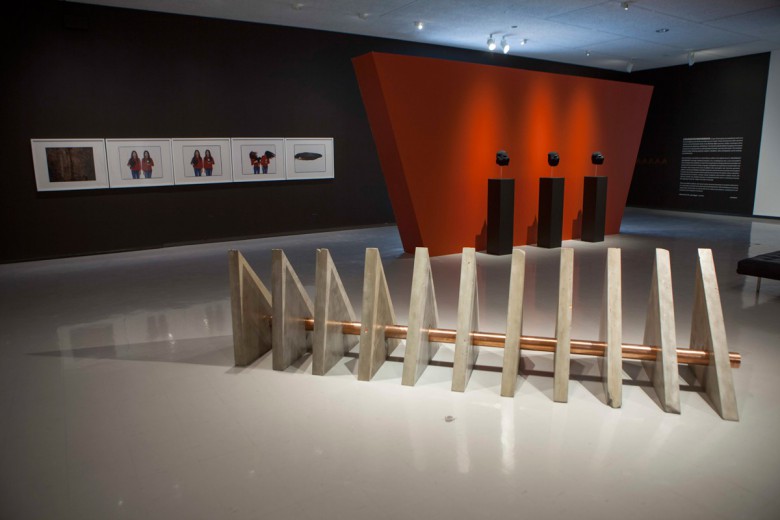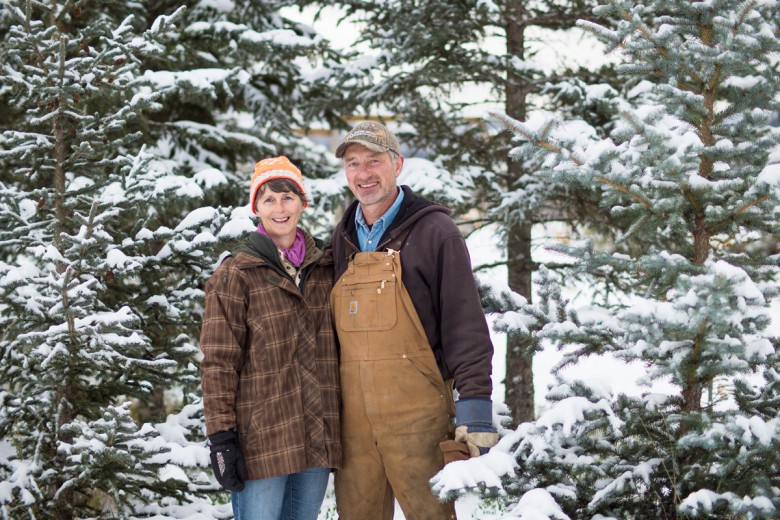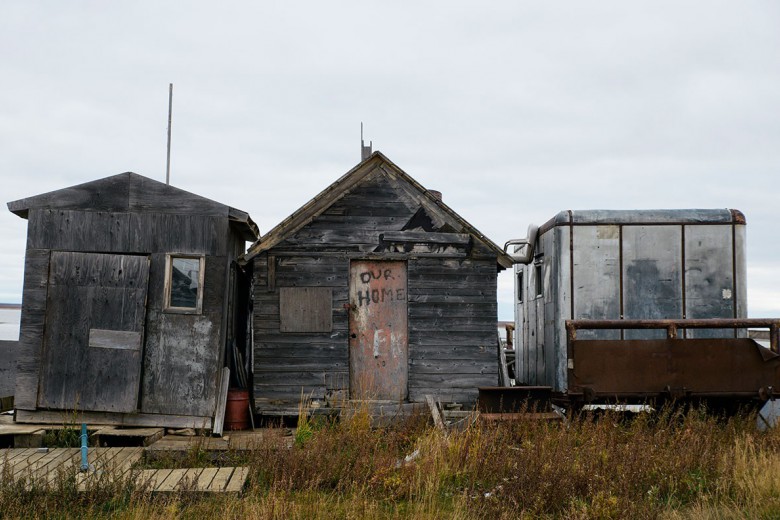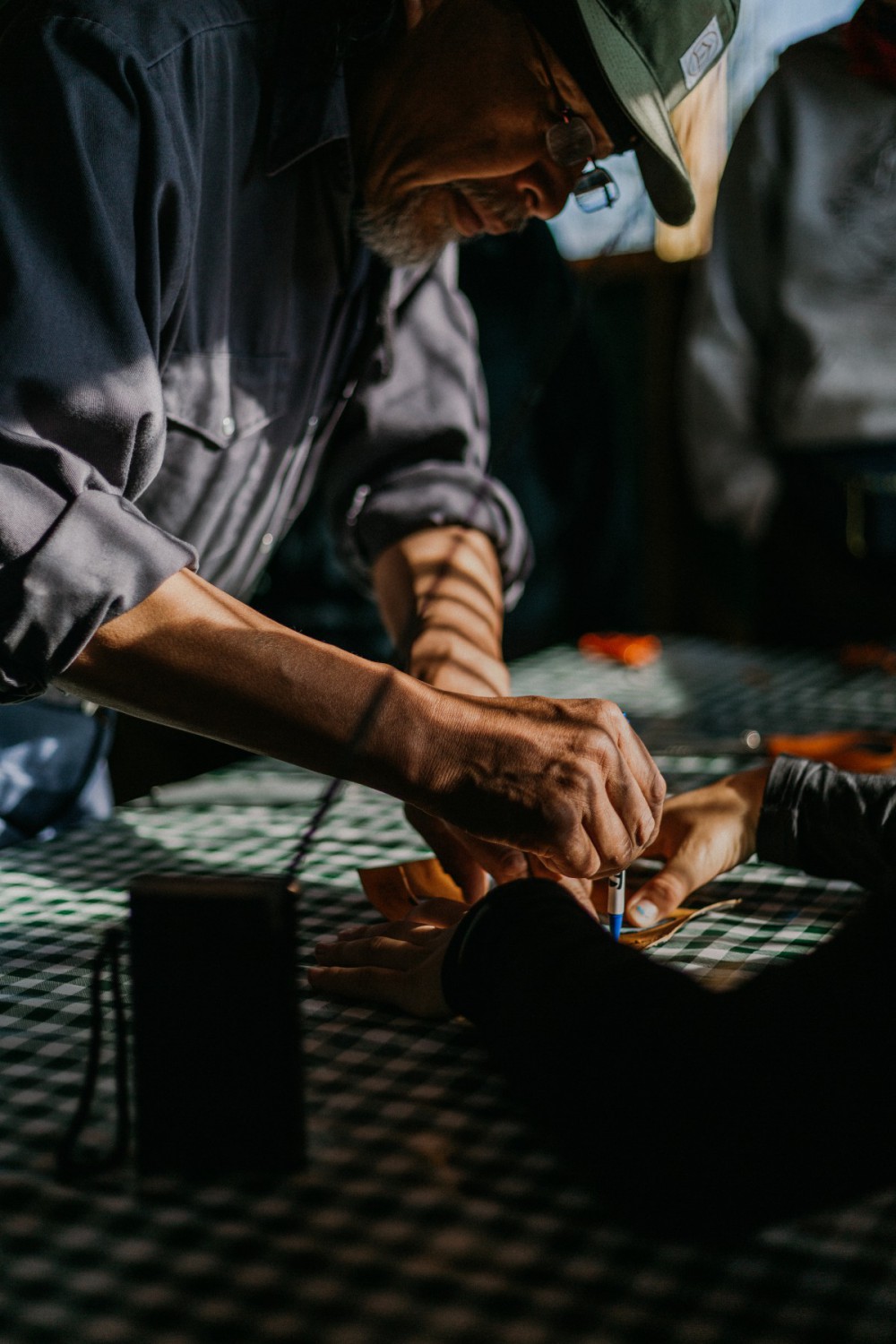
Paul Mackenzie teaches students how to craft miniature birch bark canoe models during the Dechinta Centre for Research and Learning’s fall 2020 semester. Photo by Morgan Tsetta.
I wake up early in the morning in a heat panic. The sun is already high in the sky and scorching us out of our tents. I quickly stuff my clothes back into my bag, roll up my sleeping bag, squish all the air out of my sleeping pad, and open the tent door to escape from the insufferable heat. I walk over to the camp kitchen where the camp cook made coffee, tea, eggs, toast, and beans.
I grab some food and a cup of coffee and make my way to the screened-in tent to sit on the spruce floor we wove the other day. Inside the tent, Elders Gabriel Kochon and Joe Orlias are sitting in their chairs drinking tea and sharing stories in Sahtúot’ı̨nę yatı̨́ to camp staff and youth who are listening intently. I take a seat beside Buddy Gully, a K’ahsho Got’ıne Guardian, proficient trapper and knowledge holder, who generously translates jokes and stories to me as I eat my breakfast.
We are sitting on the shores of Loche Lake, the point from which we will be starting our week-long canoe trip as part of the Dene Ts’ılı: Restoring Youth Connections camp with youth from Rádeyı̨lı̨kóé/Fort Good Hope, a small community in the Northwest Territories. The camp, organized by community member Jeannette Tobac, is attended by Elders, guardians, youth, and land-based program coordinators, and it is one of the many resurgent programs she leads. I am there as a canoe instructor. This is how we start every morning of our trip: drinking hot beverages, eating breakfast, and listening to stories in Sahtúot’ı̨nę yatı̨́ about the land we will be travelling that day.
The canoe carries me home to my nêhiyawak knowledge system, practices, and ways of being.
On this trip, youth are learning from their uncles, grandfathers, grandmothers, aunties, and friends how to canoe in a straight line and paddle against wind, while we also share snacks, crack jokes, and tell stories. The knowledge holders and Elders stop to teach us place names in Sahtúot’ı̨nę yatı̨́ and to share their histories. On the last day of the trip, we paddled along the Rabbitskin River back to Rádeyı̨lı̨kóé. The youth have all become excellent paddlers who need little to no instruction. Youth paddle up next to the motorboat along the shore; Kochon and Orlias are going to paddle the last kilometre into town with us.
We put a canoe in the water and help the Elders into the canoe. Kochon and Orlias take the lead position, and the five other canoes follow as they guide the youth home. Uncles, aunties, niblings, and grandparents paddle together back to Rádeyı̨lı̨kóé. We round the corner and are met with huge cheers as community members gather along the shore. They’re honking their car horns and firing gunshots, and the drummers start beating the caribou skin drums and singing as we near the shore. Tears well up in my eyes seeing how proud members of Rádeyı̨lı̨kóé are of the youth who went on this trek. Coming home to such a warm welcome helps the youth feel proud of their journey.
___
The canoe has been integral to the way of life in many Indigenous nations since time immemorial. Settler colonialism attempted to break Indigenous peoples’ relationship with the land, including our relationship with the canoe. In her book Inheriting a Canoe Paddle, Misao Dean writes that canoe skills were not lost because canoes were overtaken by mechanical travel. Under the Indian Act, ceremonies were outlawed, eliminating the need for ceremonial and social travel. Additionally, many Indigenous peoples no longer travelled to trade when colonization forced them to settle.
Canoe trips like the Dene Ts’ılı: Restoring Youth Connections trip have become critical for Indigenous resurgence work in the North. In Denendeh, we are seeing more and more Dene canoe trips that aim to reconnect Dene with their ancestral waterways and canoe practices. The Tłı̨chǫ government has been delivering Whaèdǫǫ̀ Etǫ K’è since 1995, where community members travel by canoe from one Tłı̨chǫ community to the community that is hosting the Tłı̨chǫ Annual Assembly to bring the energy of the land into the meetings. Dehcho First Nations runs a similar program, Yundaa Gogha, where youth travel from one Dehcho community to the community hosting the annual Dehcho Assembly. This summer, the Indigenous Youth River Guide Training program was piloted in the Yukon, where participants learned how to guide canoe trips on their ancestral waterways.
Under the Indian Act, ceremonies were outlawed, eliminating the need for ceremonial and social travel and many Indigenous peoples no longer travelled to trade when colonization forced them to settle.
All of these programs bring Indigenous peoples to the land and water and give us the opportunity to learn not only from the land, but with the land. Our thought systems and ways of being are informed by the land, so to allow ourselves to grow, to feel whole, to feel connected, and to continue to resist violent colonial disruptions, we need to be with the land. As a nêhiyaw who has been disconnected from my culture as a result of my grandmother and mother being apprehended through the Sixties Scoop, my relationship with the canoe has been critical for my reconnection with land, community, culture, and myself.
I learned how to canoe when I was 17. The first time I paddled down Miller Creek, I felt a deep sense of belonging. Miller Creek is on the homelands of the Tłı̨chǫ, about a 40-minute drive from Yellowknife. I was sitting in the bow of the canoe and my sister was in the stern. She is an experienced paddler and was teaching me how to manoeuvre around the beaver dams, fallen trees, and rocks. It was spring and we were travelling to see swans, snow geese, Canada geese, ducks, and eagles who stop at this bit of open water before continuing farther north. Being on the water working together with my sister, slowly taking in the shorelines, animals, plants, and land surrounding me and thinking about myself in relation to all of this, I realized the canoe was carrying me home.
___
I am a land-based coordinator at Dechinta Centre for Research and Learning, an Indigenous land-based university delivering accredited post-secondary educational and research experiences in the North. I am currently learning with Yellowknives Dene Elder and Dechinta bush professor Paul Mackenzie about birchbark canoe building.
In Wıìlıìdeh, birchbark canoes are called k’ıelà. Alizette Lockhart, a Yellowknives Dene Elder, taught me that k’ı means birch and elà means boat. Indigenous nations across so-called Canada, including nêhiyawak and Dene nations, designed and built beautiful, architecturally ingenious canoes adapted to the diverse environments in which they live, from coastal waters to prairie rivers to boreal watersheds.
The design and build of the canoes are informed by the materials provided by the land in each nation’s territory. nêhiyawak and Yellowknives Dene often use birchbark for their canoes, in part because birch is abundant in our territories but also because birch trees are hard, light, resilient, and waterproof. These are important qualities for a canoe in our territories because you need to be able to carry them over portages and paddle them across big lakes.
Mackenzie and I plan to build a 12-foot k’ıelà to support the resurgence of Dene canoe practices and strengthen connections to ancestral waterways and travelling routes. We have been harvesting the materials that we need from the land to construct the 12-foot k’ıelà and six-inch versions we’re building to practice. Mackenzie explained that he learned to make k’ıelà by starting with a small k’ıelà made of leftover materials and then working his way up to building bigger k’ıelà. Scaling up helps to practice the concepts before taking on a larger project.
A Dechinta student organizes birch bark to craft miniature canoe models during the Dechinta Centre for Research and Learning’s fall 2020 semester. Photo by Morgan Tsetta.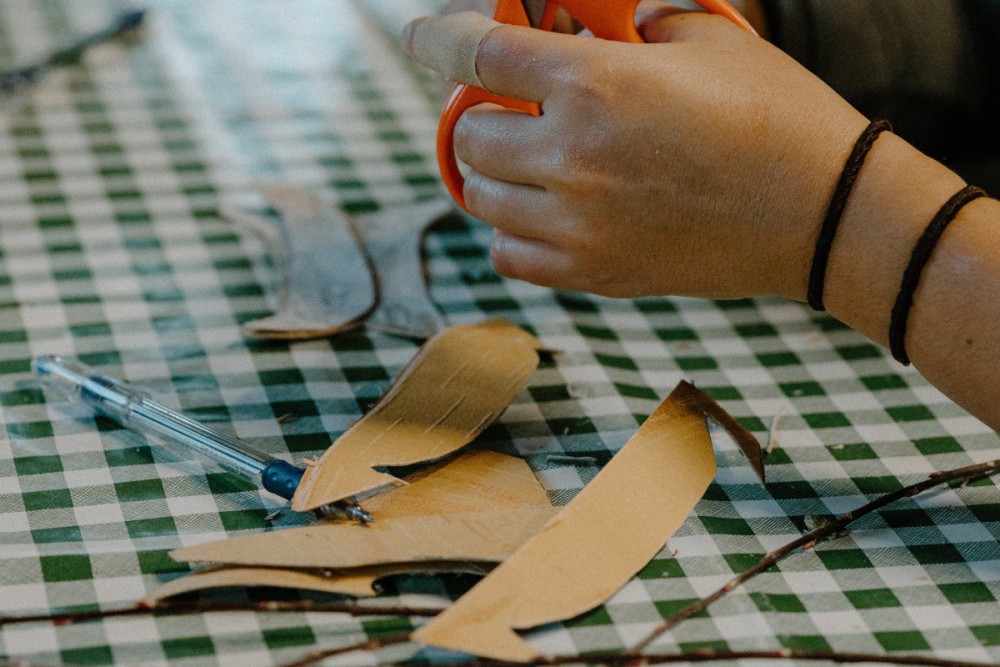
Mackenzie led Dechinta staff to harvest birch trees. We first observed the tree to see if it is ready to be harvested. Mackenzie showed me that we need to harvest trees with few knots because knots make it more challenging to peel the birchbark off the tree. He took a knife to the tree and made a shallow incision to check the thickness of the bark. It needs to be thin enough to be flexible. If the bark is too thick, it will break.
Mackenzie explained that the birch bark grain wraps around the birch tree instead of running the length of the trunk like many other trees. This makes it perfect for canoe building because the bark can easily wrap around the canoe frame from gunnel to gunnel, the upper edge of a canoe. Mackenzie patted the tree with his hand and walked away, indicating to us to harvest from this tree. We laid down tobacco before we cut it down with a chainsaw. Although it’s possible to harvest the bark without damaging the tree, we harvested the whole tree and used all parts of it so nothing went to waste. We used the bark for canoe building, the inner brown-coloured bark for medicine, and the log for a hide-scraping pole.
Next, we travelled up the Wıìlıìdeh to harvest spruce roots. Mackenzie brought us to a landslide, where spruce roots were more exposed. I worked with Gordie Liske, a land-based educator and knowledge holder at Dechinta, to use an axe to pull up the roots, which we used to sew the canoe together. My arms were full carrying a big pile of spruce roots back to the boat, where Mackenzie told me, “We need three times more of that. See, this is why I told you it’s a lot of work.”
I feel my ancestors in the birch, spruce, and tamarack, wrapping themselves around me and holding me. I carry them with me as I navigate rivers, carry heavy boats over ancient portage trails, and paddle along lake shorelines.
After pulling up more roots, we needed to harvest tamarack trees to build the frame and spruce gum to boil down with fat to create spruce pitch to make the k’ıelà waterproof. For the six-inch k’ıelà, we flattened a seven-inch square of birchbark for the base and harvested thin, straight willow branches for the gunnels. We peeled the bark off the willow branches and sewed them and birchbark together with artificial sinew. We installed a little wooden seat across the middle and a mini paddle strapped to the seat in the k’ıelà.
Not only do the materials to build a canoe come from the land, but the design of the canoe is determined by how it will be used and where it will be paddled. Yellowknives Dene territory in Treaty 8 is dotted with lakes and connected by portages. The k’ıelà is very light and easily carried. It is also less likely to be damaged because we can carry it instead of canoeing through boulder-filled pool-and-drop rapids.
Birchbark canoes vary in size depending on the route, cargo, and purpose of travel. Fred Sangris, Yellowknives Dene’s N’Dılǫ Chief, explained that “the Yellowknives Dene had a small k’ıelà that was used for ratting [harvesting muskrats], and we also had a larger canoe with a long, curved head that helped cut through big waves while travelling on Tındeè [Great Slave Lake].”
Learning from Mackenzie has helped me understand how relationships with spruce, birch, tamarack, and willows are embedded into the canoe from the moment they are harvested, to being stitched and wrapped together, to travelling with us as we cross lakes, walk portages, and paddle down rivers. I can see that the land is stitched, bent, tied, and wrapped thoughtfully and intentionally into each inch of the canoe.
Although the canoes I paddle today are made of synthetic materials like Royalex or Kevlar instead of birchbark, nêhiyawak innovative genius continues to be reflected in the design of modern-day, appropriated canoes. I feel my ancestors in the birch, spruce, and tamarack, wrapping themselves around me and holding me. I carry them with me as I navigate rivers, carry heavy boats over ancient portage trails, and paddle along lake shorelines. The canoe is resistance to colonial policies and occupation. The canoe carries me home to my nêhiyawak knowledge system, practices, and ways of being. The canoe is home.
This article was the winner of Briarpatch’s 2022 Northern Writing Prize.


